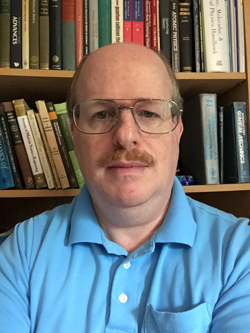Daniel Crowe 2016 Election Bio
 Daniel M. Crowe
Daniel M. Crowe
Loudoun County Public Schools, Academy of ScienceSterling, VA 20164
dan.crowe@lcps.org
Education
B.S. Physics, Manhattan College, 1982
B.E. Electrical Engineering, Manhattan College, 1983
M.A. Physics, City College of New York, 1986
Ph.D. Physics, City University of New York, 1995
Professional Experience
Pacific Union College, Assistant Professor of Physics, 1990-1994
Petaluma High School, 1996-1997
Justin-Siena High School, 1997-1999
Invention Machine Corporation, Science Editor, 1999-2001
Oklahoma School of Science and Mathematics, 2002-2006
Loudoun County Public Schools, Academy of Science, 2006-present.
Memberships
American Association of Physics Teachers
American Physical Society
National Association for Research in Science Teaching
AAPT/APS Activities
Committee on Physics in High Schools, member, 2008-2011, 2014-2017, vice chair, 2015-2016, chair, 2016-2017
Committee on Research in Physics Education, member, 2011-2014
Nominating Committee, 2012
Meetings Committee, 2012-2016
Executive Programs Committee, 2015-2018
Organized High School Physics Teachers' Day since 2011 Summer Meeting
APS Forum on Education Executive Committee, member-at-large, 2012-2015
Commentary
AAPT has made it through turbulent financial waters, and the shores of stability are in sight, but will it be knocked off course by the winds of change? AAPT faces challenges in the next few years regarding two key constituencies: the PER community is gaining increasing recognition in APS, and the number of high school teachers who are AAPT members has been declining. Both of these challenges require AAPT to demonstrate its relevance to these constituencies with new urgency. Outreach to the high school community has increased recently via the High School Physics Teachers' Day, the High School Physics Camp, and the hiring of a K-12 Program Manager. We need to continue to find ways to meet the needs of both of these constituencies and physics educators in general. This requires us to continue to develop ways to determine these needs. We also need to determine and eliminate issues that keep physics teachers from participating in AAPT. All of this requires open dialogue between the leadership and membership and between the membership and the physics education community at large. Every member has an important role to play. The Board of Directors can help to organize the efforts of the members to maximize their effectiveness.

